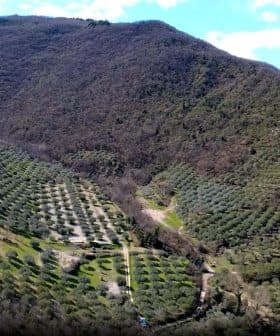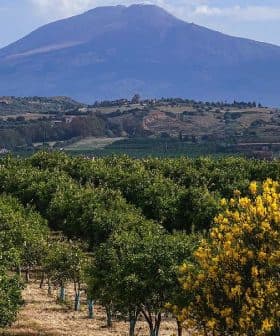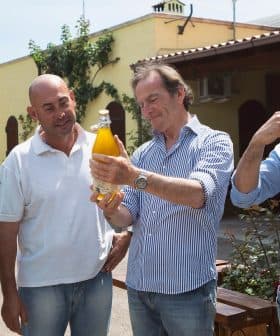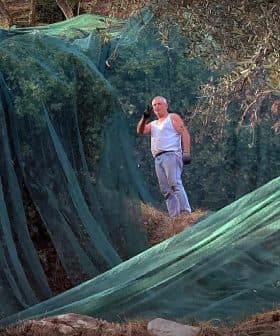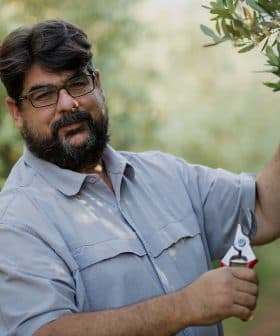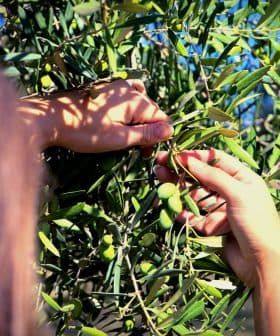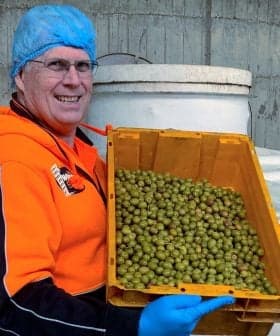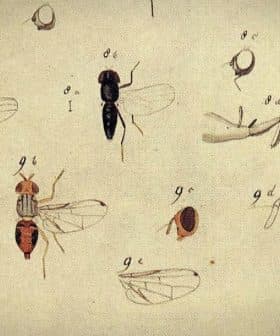Researchers Work to Reverse Genetic Erosion, Breed Resilient Olive Varieties
Understanding the genetic diversity of olive varieties will help farmers select the best cultivars for their climate and phytosanitary environment.
 A plot of the olive germplasm collection of CREA-OFA in Mirto-Crosia
A plot of the olive germplasm collection of CREA-OFA in Mirto-Crosia Biodiversity, particularly in olive trees, is gaining attention among researchers and agri-food sector operators to counteract genetic erosion and develop more resilient varieties. Italy has the richest genetic diversity of olives, with researchers working on identifying improving mutations through genome editing techniques to enhance traits like disease resistance and productivity.
At the center of the global discussion around the link between sustainable development and climate change, biodiversity is generating more interest.
In terms of olive biodiversity, recent years have seen a growth of attention among operators in the agri-food sector and researchers, who are committed to counteracting genetic erosion, as well as to studying and breeding more resilient varieties.
A wide biodiversity is useful for researchers who want to carry out new breeding programs.
“The olive tree (Olea europaea subsp. europaea) is a very ancient tree species with a great wealth of genetic diversity,” said Samanta Zelasco, a researcher at the Center for Olive, Fruit and Citrus Crops of the Council for Agricultural Research and Agricultural Economics Analysis Research (CREA-OFA) of Rende, in Calabria.
“First, we must clarify that ‘genetic diversity’ is the scientific definition that in the public debate is generally substituted by ‘biodiversity,’” she added.
See Also:Genotype Plays Significant Role in Fatty Acid Content of Virgin Olive OilAccording to the last official calculation carried out by CREA in 2012 on the United Nations Food and Agriculture Organization’s Second Report on the State of Plant Genetic Resources for Food and Agriculture, the olive germplasm present in the major ex situ collections in the world amounted to at least 2,629 different varieties.
Italy has the richest genetic diversity, with 734 denominations listed in the national register of fruit plant varieties, updated in 2020 by the Italian Agriculture Ministry.
“Italy boasts a very high number of varieties, and the composition of its olive germplasm is the largest and most varied in the world,” Zelasco said. “Being in the center of the Mediterranean, over millennia, the country has undergone several historical events and people movements that have favored the importation and exchange of plant material, contributing to enriching its varietal heritage.”
Today, frequent reports of allegedly new genotypes indicate a great germplasm diversity. Yet, researchers warn that the precise number of varieties cannot be defined with certainty due to multiple cases of synonymy and homonymy.
“We recently carried out an in-depth molecular investigation of the Italian varieties using a very large number of markers that cover almost the entire genome,” Zelasco said. “We have not completed the study yet, but we can already say that presumably a good part of the genetic material, perhaps half, is represented by cases of synonymy.”
“The same probably happens in other countries,” she added. “Still, Italy has a huge number of varieties, which are the result of local selections. In most Italian regions, we can find about 30 to 40 varieties, then a wide germplasm also at a local level.”
Several lines of scientific evidence indicate that the domestication area of the olive tree is the Levant (i.e., the Eastern Mediterranean region that includes present-day Cyprus, Israel, Jordan, Lebanon, Syria, Palestine and most of Turkey), from which it was spread around the Mediterranean basin.
The vegetative propagation played a crucial role, for which reason a lot of synonymy cases can be found in olive germplasm – Zelasco provides the example of the Tuscan variety Santa Caterina that shows the same molecular profile of the Spanish cultivar Gordal Sevillana. Meanwhile, the olive tree has differentiated locally, generating many varieties.
“When cases of synonymy, namely different denominations of the same cultivar, come into play, there may be commercial problems,” Zelasco said. “Legal disputes relating to the sourcing of table olives and extra virgin olive oils from different geographical sites than those envisaged by the Protected Geographical Indications (PGI) and Protected Designation of Origin (PDO) production regulations are increasingly frequent.”
“The resequencing of the genomes of the varieties included in the specifications could help to select cultivar-specific markers able to unequivocally identify the single varieties and provide a more effective genetic certification system,” she added.
In the current context, where research aims to identify solutions in the field of sustainability, a rich and varied gene pool can become useful also to draw genes for genetic improvement programs.
“A wide biodiversity is useful for researchers who want to carry out new breeding programs,” Zelasco said. “The first step is to understand the behavior of a variety at an agronomic level, to detect the genes in its DNA which improve particular traits, or rather the mutations within the genes responsible for the improvement of the agronomic traits.”
To observe the genetic expression of diverse varieties, their behavior must be studied in a single environment, hence the importance of collections.
“It takes years to phenotype and characterize a variety since we must consider ‘on-years’ and ‘off-years’ in the olive tree’s alternate bearing cycle, and we need robust data repeated at least over three or four years,” Zelasco said.
“Since most of the agronomic traits are conditioned by the environment, the varietal comparison must also be extended to other environments that can be precisely represented by the collections containing common varieties,” she added. “Once the comparison among varieties has been concluded, we can trace what genes are involved and the mutations which are responsible for the improving traits.”
Currently, such mutations are used in the innovative genomic technique called genome editing, which is part of the assisted evolution techniques, the latest novelty in the sector. Genome editing consists of a punctual modification of the genome in a specific site, differing from the traditional mutagenesis that acts randomly.
“The improving mutations are identified through a statistical approach, and we do not transfer the DNA, but we identify the sequences and give instruction to an enzymatic complex which is able to reproduce the mutation,” Zelasco said.
“This is a clear example of enhancing the genetic diversity of the olive tree,” she added. “Namely, we identify the improving traits and reproduce them in the variety to be improved without altering its genetic background.”
To take one concrete example, Carolea, the most widespread variety in Calabria, is one of the cultivars studied by CREA researchers for its susceptibility to Spilocaea oleaginea, which causes the peacock spot disease, a potentially significant phytosanitary problem.
“Recently, we have phenotyped the susceptibility to Spilocaea oleaginea of at least 150 varieties in our collection, and therefore we will soon be able to identify the improving mutations by relating the genotype to the phenotype,” Zelasco said.
“The genes responsible for the plant’s response to the pathogen have also recently been identified by the research group of the University of Palermo,” she added. “Then, in the next few years, we will probably be able to reproduce the improving mutation in this variety through the genome editing technique and therefore to have an improved Carolea that tolerates peacock spot.”
Considering the reduction of phytosanitary treatments with plants less susceptible to certain diseases, research on innovative genomic techniques pave the way for the selection of more plants suitable for new climatic scenarios.
Finally, the study of germplasm makes it possible to rediscover varieties that had been set aside and which have characteristics that can prove to be useful in the current context.
“I can bring the example of a neglected Apulian variety called Toscanina, which has a very high content of oleic acid and phenolic compounds and enters production early while being quite productive with a moderate alternation,” Zelasco said.
“We are now testing it for tolerance to water stress and biotic stress,” she added. “This kind of information is still missing since these aspects have recently become a priority for the scientific world.”
At the time of writing, five new accessions are ready to be included in the CREA’s collection in Mirto Crosia, located on the Ionic coast of Calabria, in the province of Cosenza – having been genetically characterized, the accessions have unique molecular profiles.
“These are still unpublished accessions, therefore potential new varieties, which do not have a defined name yet,” Zelasco said.
She specified that they had been found in Calabria and other Italian regions, and some of them come from root suckers of centuries-old, monumental plants, including one from the rootstock of the Olivone of Fibbianello in Semproniano, Tuscany.
“Monumental olive trees are an interesting object of study to understand the phylogenesis of the species,” Zelasco said. “A very thorough genomic analysis allows us to understand how the species has evolved from the domestication phase to date.”
“A current trend is indeed to create collections of wild plants, and a new collection of this kind has been recently created in Croatia,” she added. “We must consider that wild olive material is a reservoir of new genes very useful for a breeding program, especially for identifying more resilient agronomic traits.”
Share this article


